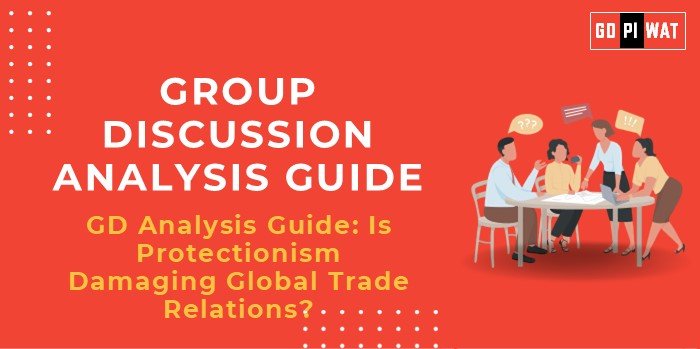📋 GD Analysis Guide: Is Protectionism Damaging Global Trade Relations?
🌐 Introduction to the Topic
Opening Context: Protectionism—marked by trade barriers such as tariffs and quotas—has resurged as nations respond to economic challenges like supply chain disruptions, domestic unemployment, and global competition. Its impact on global trade is hotly debated, particularly in the era of globalization.
Topic Background: Historically, protectionism rose during crises such as the Great Depression. While it aims to safeguard domestic industries, it can strain international relations and stifle trade growth. The recent US-China trade war, Brexit, and COVID-19 supply chain strategies highlight its growing relevance.
📊 Quick Facts and Key Statistics
- 📉 Global Trade Growth (2023): Slowed to 1.7%, compared to 2.7% in 2022 (World Trade Organization).
- 📈 Tariff Increases (2022-23): Average tariffs in G20 economies rose by 3%.
- 💸 Impact of US-China Trade War: Estimated $500 billion loss to global GDP since 2018 (IMF).
- 🌍 Free Trade Agreements (FTAs): Over 350 FTAs globally, many stalled due to protectionist policies.
🔗 Stakeholders and Their Roles
- 🏛️ Governments: Regulate trade policies and negotiate treaties.
- 🏢 Businesses: Influence policies to protect or expand market access.
- 👷 Workers: Seek job security; benefit from domestic focus but risk inflation.
- 🌐 International Bodies: WTO monitors and regulates trade practices.
🏆 Achievements and Challenges
✨ Achievements
- 🏗️ Domestic Industry Growth: Tariffs on steel increased US production by 6% (2023).
- 👨🏭 Job Protection: India’s tariffs on electronics have boosted domestic assembly industries.
- ⚖️ Short-term Stability: Nations can shield key sectors during crises.
⚠️ Challenges
- 🔄 Economic Retaliation: The US-EU dispute over subsidies caused a $10 billion decline in bilateral trade (2021-23).
- 🔗 Supply Chain Disruption: Over-reliance on local resources limits efficiency.
- 🌍 Global Inequality: Developing nations face higher barriers to export goods.
🌍 Global Comparisons
- 🇰🇷 Successful Example: South Korea transitioned to open markets post-1970s protectionism, becoming a global leader in technology exports.
- 🇦🇷 Challenge Example: Argentina’s import substitution policy (2010-20) led to inflation and reduced competitiveness.
📚 Structured Arguments for Discussion
- Supporting Stance: “Protectionism ensures domestic jobs and industries thrive amidst global economic instability.”
- Opposing Stance: “It hampers international collaboration, inflates prices, and disrupts global supply chains.”
- Balanced Perspective: “While necessary during crises, prolonged protectionism risks economic isolation and inefficiencies.”
💡 Effective Discussion Approaches
✨ Opening Techniques
- Use data: “Global trade growth slowed to 1.7% in 2023 due to rising protectionist policies.”
- Highlight contrasts: “Though it secures jobs, it inflates consumer prices and disrupts global partnerships.”
📌 Counter-Argument Handling
- 💼 “While tariffs may secure jobs, WTO findings show they often backfire by reducing global demand.”
📈 Strategic Analysis of Strengths and Weaknesses
- 💪 Strengths: Protects local jobs, mitigates crises.
- 🛑 Weaknesses: Stifles competition, increases costs.
- 🌟 Opportunities: Encourage innovation in self-reliance.
- ⚠️ Threats: Trade wars and retaliatory policies.
🎓 Connecting with B-School Applications
📚 Real-World Applications
Links to supply chain management and global strategy courses.
🤔 Sample Interview Questions
- “How can companies adapt to rising protectionist policies?”
- “Discuss the role of WTO in addressing trade imbalances.”
✨ Insights for Students
- Understand trade-offs in policy-making and the importance of negotiation skills.


